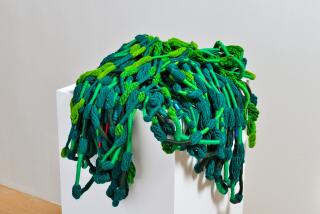Fowler Museum Pairs Embroidery, Photos to Fascinating Effect
For sheer visual splendor, “Threads of Light: Chinese Embroidery From Suzhou and the Photography of Robert Glenn Ketchum” is an exhibition that shouldn’t be missed. At UCLA’s Fowler Museum of Cultural History, this seemingly odd pairing of the ancient art of embroidery and the modern art of photography raises so many fascinating questions about the strengths and limitations of these apparently unrelated media that the age-old battle between photography and painting pales in comparison.
Just inside the entrance to the first of two galleries stands “One Hundred Butterflies,” a dazzling image of 100 exquisitely detailed butterflies, each of which appears to be suspended in midair. To viewers unfamiliar with fine embroidery, this approximately 3-by-4-foot work may initially resemble a stunningly realistic picture painted on a semi-translucent sheet of milky white glass, or an extraordinarily sophisticated stained-glass window.
Only a close viewing reveals the innumerable strands of hand-dyed silk that have been meticulously stitched into the tautly stretched rectangle of silk gauze. Both the multicolored threads and tightly woven fabric reflect, absorb and transmit light. As the eye moves across the piece’s subtly textured surface, highlights flicker and shimmer off each stitch, endowing the whole with a sense of delicate animation.
But “One Hundred Butterflies” is also a two-sided image, equally beautiful on both sides. It’s translucency allows viewers to see the ghostly silhouettes of others on the opposite side, adding to the work’s power and increasing the impression that the butterflies occupy three-dimensional space. It is as if the three artists (Ren Huijuan, Shi Yi and Zhu Huifen) want to double your pleasure while flaunting their virtuosity and, simultaneously, outdoing the painter (Huang Xiang) on whose canvas their image is based.
Sixteen other works depicting carp, ducks, geese, magnolia blossoms, peonies, a snow-white peacock, a mountain landscape and a stylized cityscape (whose four panels are 21 feet long), complement the crystalline clarity of “One Hundred Butterflies.” Filling the first gallery with an impressive variety of styles, techniques and materials, these consummately crafted images by 26 members of the Suzhou Embroidery Research Institute provide the first view outside China of the institute’s marvelous work.
In the second gallery, 13 embroidered landscapes hang on the walls or stand in tabletop and free-standing screens. Each is paired with a gorgeous landscape photograph by Ketchum that served as the source for the embroidered image.
Even viewers familiar with Chinese embroidery may be perplexed by these breathtaking innovations. Initially, it’s difficult to distinguish between the printed and embroidered images.
All but one of the silk works are exactly the same size as the photographs from which they were taken. Likewise, the compositions are nearly exact matches. Some of the palettes stray from their sources, but most are remarkably faithful. What is immediately apparent is that these embroidered images are very different from the fine, petit-point and random-stitch works in the first gallery.
To look carefully at the pairs of works on silk and paper is to see that the embroidered landscapes are more textured and reflective than the photographic ones, which, for their part, give a greater impression of illusionistic depth and include more subtle color gradations. Ketchum conceived the collaboration, which started in 1986, because he was interested in working with textured surfaces, in contrast to the smooth sheen of Cibachromes and silver prints.
One of the best aspects of the second half of the exhibition, which was organized by Dr. Patrick Dowdey, is that it’s impossible to say whether photography or embroidery is a better medium for depicting the landscape. Instead, formal differences between the two forms are clarified and accentuated without one taking priority over the other. Viewers who still believe that painting and photography are embattled art forms have a lot to learn from “Threads of Light,” in which even more unrelated media highlight one another’s best effects.
* “Threads of Light: Chinese Embroidery From Suzhou and the Photography of Robert Glenn Ketchum,” UCLA/Fowler Museum of Cultural History, 405 Hilgard Ave., Westwood, (310) 825-4361, through Sept. 5. Closed Mondays and Tuesdays. Admission, free; parking, $5.
More to Read
The biggest entertainment stories
Get our big stories about Hollywood, film, television, music, arts, culture and more right in your inbox as soon as they publish.
You may occasionally receive promotional content from the Los Angeles Times.










